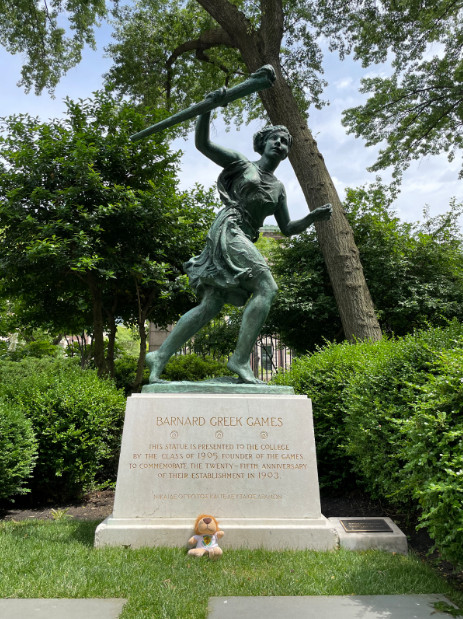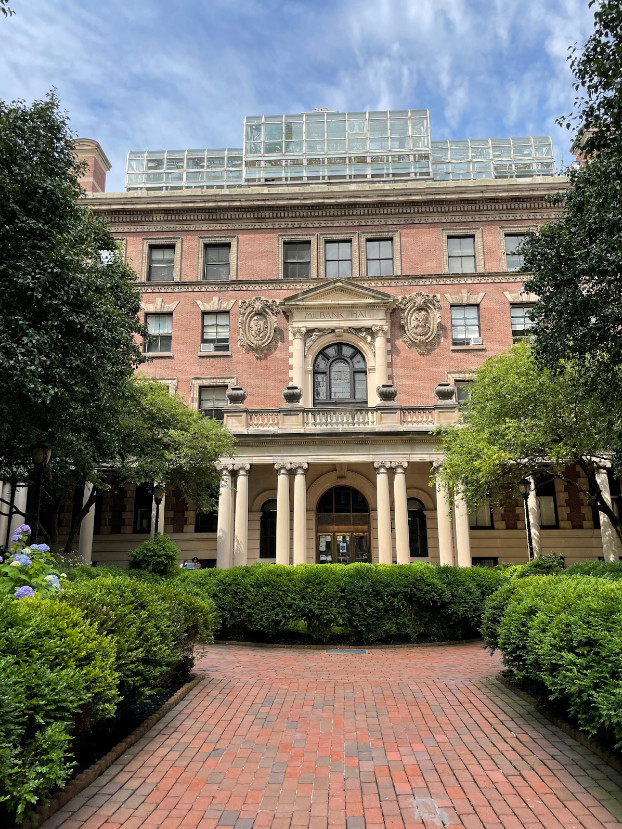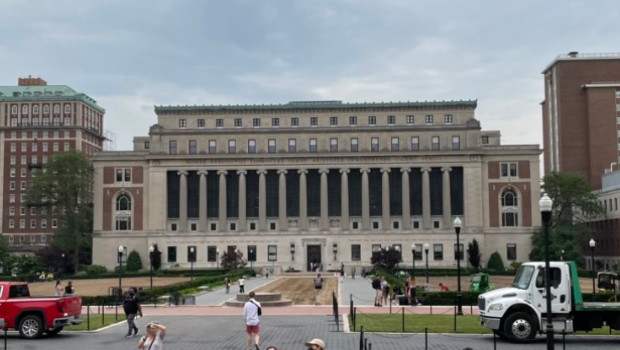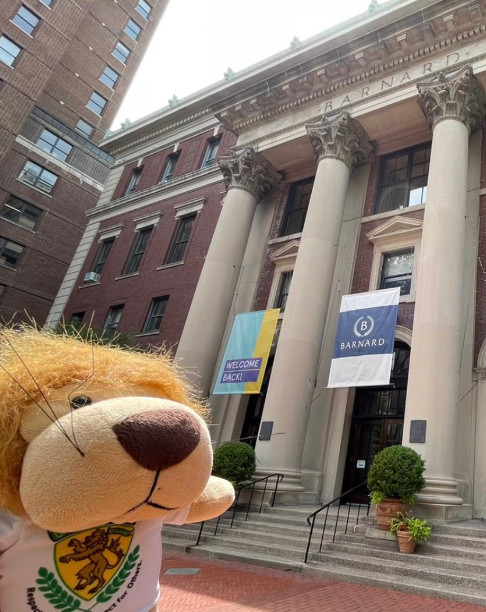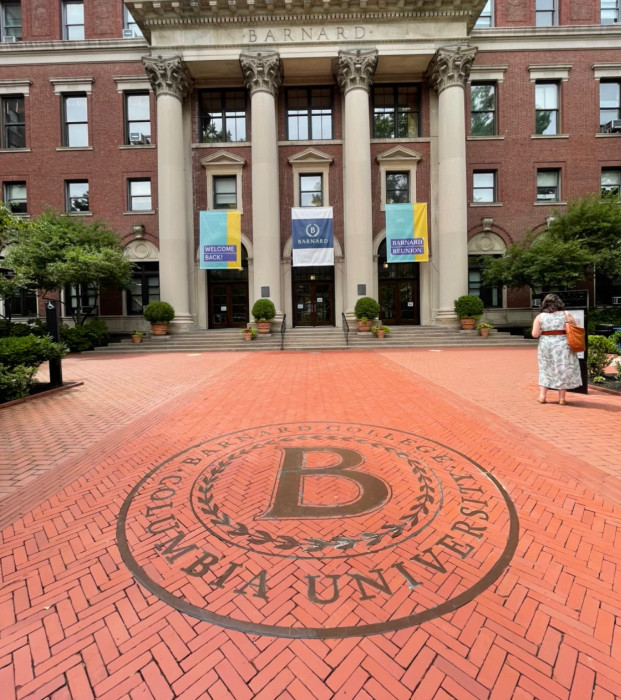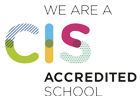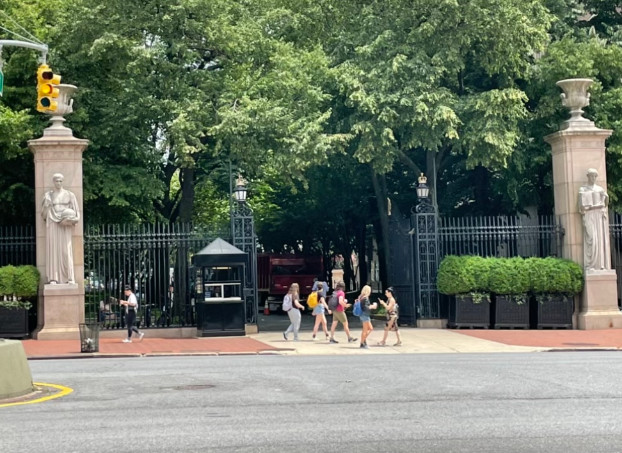Today we head further uptown, taking the 1 Train to 116th Street, home of my alma mater, Columbia University! It’s been many years since I’ve visited, but despite the current renovations and some changes in nearby restaurants, the university has the same stately feel as we stroll through its iconic gates and onto College Walk, a pedestrian pathway that cuts through the campus and connects Broadway and Amsterdam Avenues.
The Columbia gates are open to all, and this time of year there seems to be more tourists and visitors walking through them than students. Along with other out-of-towners, the Uplands Lion immediately began posing for selfies in front of the Low Library, which has become a sort of symbol for Columbia University, but here’s a fun fact that most tourists do not know: The Low Library is not a library. Nowadays, it is primarily an administrative building. The actual library is located across the street in another beautiful building that is much less photographed.
As the lion meanders around with his selfie stick looking for photo-ops, why don’t we stroll around Columbia and its surrounding affiliated colleges (this part of Manhattan is like an educational metropolis), while we continue our conversation from the previous post about the American emphasis on a well-rounded education. International students tend to be attracted to Columbia because it is an Ivy League University, but they do not realize that the Ivy League colleges tend to be rooted in the liberal arts tradition, and they value well-roundedness regardless of a student’s major.
Columbia’s Core Program, which is very much like the IB Core, is a fantastic example of this. It has a heavy emphasis on evaluating sources (shout out to the IB Extended Essay!) and perspectives on thinking (shout out to IB’s Theory of Knowledge!). This shows you that even universities that are not typical liberal arts colleges, still tend to emphasize liberal arts values.
Let’s cross over to the other side of Broadway and visit Barnard College, which is an all-womens’ college affiliated with Columbia.
Fun Fact: Barnard, founded in 1889, was one of the original “Seven Sisters,” a group of highly selective women’s liberal arts colleges that were established to provide women with the opportunity to receive a top-notch education on par with Ivy League universities at a time when these universities were not open to women.
Today, Barnard is still an all-women’s liberal arts college, and Barnard students can also enroll in courses at Columbia University. Barnard has the best of both worlds: the small, friendly liberal arts feel with all of the access to facilities and labs of a renowned research university. Barnard’s liberal arts tradition is very much a part of its educational philosophy today, and all of its students take Arts and Humanities courses, Physical Education, and six different Modes of Thinking courses, such as Thinking Through Global Inquiry.
Yes, that’s like taking six TOK or Knowledge Perspective courses! That sounds like so much fun to me! Does that sound like fun to you? If it doesn’t, then this is a terrific lesson in remembering to look beyond the rankings of the universities that interest you. You also should investigate the school’s curriculum and see whether its educational philosophy is the right fit for you. Although Columbia and Barnard have excellent reputations, their emphasis may not be the “best fit” for everyone. With Columbia’s acceptance rate of less than 7%, it is clear that the university is seeking not only academically strong students, but also students who would be a best fit for its type of education and its community culture.
How about you?
- What do you think is the value of taking so many “Modes of Thinking” classes? Why would an academically rigorous college value such courses? Does learning about the Columbia and Barnard emphasis on these courses change how you view your Knowledge Perspectives or TOK classes?
- Even though women have the same access to higher education that men do nowadays, Barnard is still one among several highly selective all-women’s colleges. Why do you suppose so many young women desire to attend an all-women’s university? When you are working on a group project, do you find that you work better with a single-gendered group or with a mixed-gendered group? Or do you not notice a difference at all?
- Would you prefer a liberal arts style of education in which you are also focusing on arts and humanities courses in addition to your main course of study? Why or why not?
